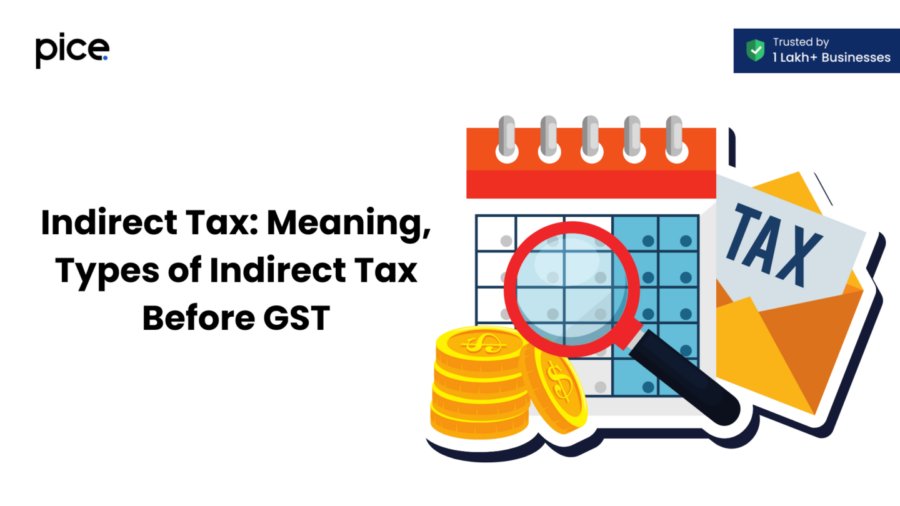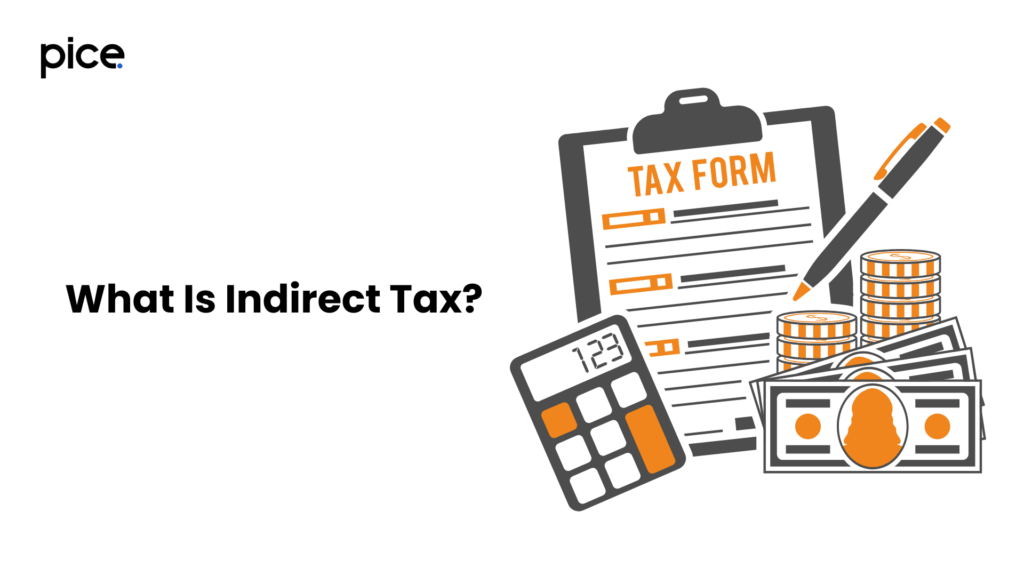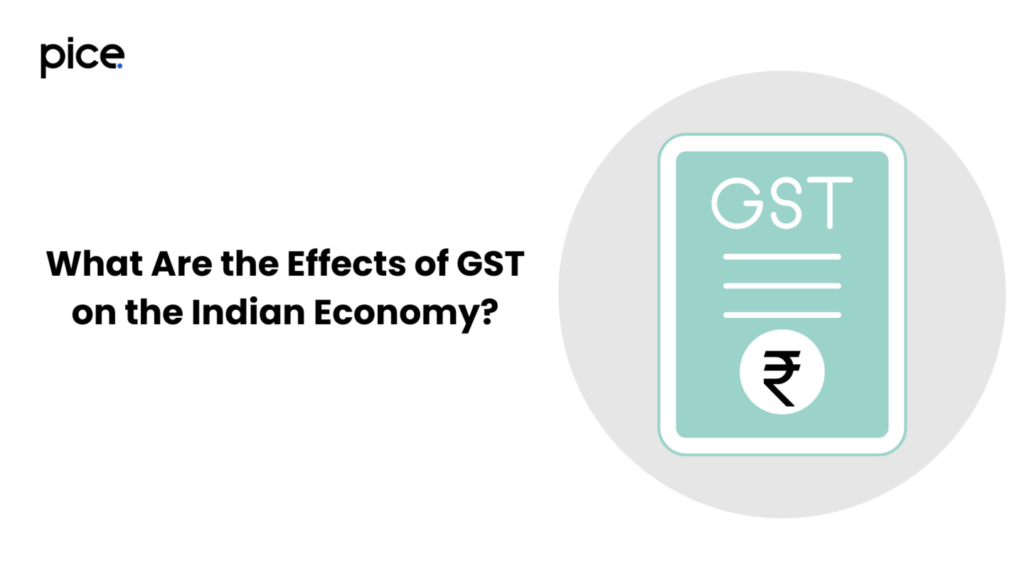Indirect Tax: Meaning, Types of Indirect Tax Before GST
- 20 Sep 24
- 11 mins

Indirect Tax: Meaning, Types of Indirect Tax Before GST
Key Takeaways
- Indirect Taxes: Collected on goods and services, passed from businesses to consumers, and remitted to the government.
- Types: Include GST, VAT, excise duties, customs duties, and service tax.
- Advantages: Generate revenue, encourage fiscal discipline, control consumption, and reduce tax evasion.
- GST: A comprehensive tax that customers ultimately pay at each stage of the supply chain.
- Economic Impact: Simplifies taxation, boosts logistics efficiency, reduces production costs, and enhances competitiveness.
Are you wondering about the meaning of indirect tax? Simply put, indirect tax is collected by intermediaries from consumers, who in turn, bear the complete economic burden of the tax. Its types include GST, VAT, excise duties and many more. Individuals do not directly pay indirect taxes to the Indian government like they do with direct taxes.
Precisely, indirect taxes are levied on the production or consumption of goods and services by the Central Government and then added to the final price of goods and services. In this blog, we will walk you through a detailed guide on this taxation system, highlighting the different types of indirect tax before GST, benefits and other requisites.
What Is Indirect Tax?

Businesses involved in selling goods and services are a source of collection of indirect taxes. When a business sells a product, it includes the tax in the sale price. The consumer pays this price, which is inclusive of the tax. The business then collects the tax from the consumer at the point of sale. The government receives remittance of the tax that has been collected, periodically.
These taxes are regressive, meaning they take a larger percentage of income from low-income earners. Since the government collects them from businesses rather than individuals, indirect taxes are also easier to collect than direct taxes. This process reduces administrative costs and increases efficiency. A point to highlight is that such taxes can influence consumer behaviour by making certain goods more expensive. For example, high taxes on tobacco aim to reduce smoking.
They are often seen as less transparent because consumers are not able to consider the tax separately. However, despite their drawbacks, indirect taxes play a crucial role in the economy. They help fund public services and infrastructure development. Most importantly, State and Central Governments use indirect taxes to raise revenue and control certain economic activities.
How are Indirect Taxes Collected?
Businesses involved in selling goods and services are a source of collection of indirect taxes. When a business sells a product, it includes the tax in the sale price. The consumer pays this higher price, which is inclusive of the tax. The business then collects the tax from the consumer at the point of sale. The government receives remittance of the tax that has been collected, periodically.
Businesses, in order to ensure efficient remittance of tax, must keep accurate records of sales and the collection of sales tax. They not only use point-of-sale systems to track transactions and tax amounts but the central authority also sets specific reporting periods. These periods can be monthly, quarterly or annually.
They file a tax return, detailing the collection of the total taxes. The business sends the tax payment to the relevant tax authority. Otherwise, failure to remit collected taxes can result in penalties and interest charges. This process helps maintain the integrity of the tax system, properly and dutifully.
What Are the Different Types of Indirect Taxes?
There are some common types of indirect taxes prevailing in India. Some of which are discussed below:
- Service Tax in India: Service providers charge this tax on the taxable services they provide. In this case, the recipient(s) of those services have to pay the tax.
- Excise Duty in India: Indian businesses are required to pay Central Excise Duty on their products. The company, in this case, pays the tax and eventually recovers it from the consumers.
- Value-Added Taxes in India: This is one of the types of taxes, that are imposed on any movable product. It includes the Central Sales Tax that the Central Government of India levies.
- Customs Duty in India: Customs Duty, also known as import duties, is charged on any goods imported to India. Sometimes, it is also levied upon goods that are being exported out of India. In such cases, it goes by the name of export duties.
- Securities Transaction Tax (STT): Securities Transaction Tax is levied on trading securities on the Indian Stock Exchange.
- Stamp Duty: While moving an immovable item in an Indian state, the government of the particular state charges a tax which goes by the name of stamp duty. It is generally levied on all kinds of legal documents.
- Entertainment Tax: This tax is imposed on the purchase of any product related to entertainment. Charged by the State Government, it includes taxable services such as purchase of movie tickets, football matches, amusement park tickets, winnings from video games and so on.
What Are the Benefits of Indirect Tax?
Following are the wide range of advantages derived from indirect taxes:
- Revenue Generation: The abundant contribution of these taxes to the government revenue is a major advantage. Collected at more than one stage of the supply chain, it ascertains a broad network of revenues, which can, in turn, be used for public welfare by the government.
- Progressive Nature: Unlike direct taxes, they are not dependent on the income of an individual. Therefore, higher the income, the more likely a person is to buy products with indirect taxation. This further goes on to create an economic equilibrium amongst the national population.
- Encouraging Fiscal Discipline: Indirect taxes ensure fiscal discipline by keeping expenditures on the government's part under check. The majority of the government's revenue comes from indirect taxes. Therefore, the government is compelled to use it effectively.
- Controlling Consumption Patterns: These taxes play a huge role in shaping consumerism patterns. Higher indirect taxation on harmful products such as tobacco and alcohol cut down on its consumption.
- Flexible Policy Tool: When there is economic growth, it is possible to increase the tax rates to generate additional revenues. Similarly, when there is a downslide in the economy, tax rates can be lowered to ensure consumer satisfaction. This makes indirect taxes an efficient economic regulator.
- Reduced Tax Evasion: The evasion of these taxes is relatively more difficult, as these are levied upon prices of day-to-day goods and services. Therefore, unlike direct taxes, it becomes difficult to evade indirect taxes.
What Are the Disadvantages of Indirect Taxes?

There are a few disadvantages of indirect taxes. Let us have a look at them:
- These taxes might prove to be regressive at times. For instance, often, the taxes might generate a higher revenue from individuals with lower incomes.
- The cascading risk of tax-on-tax exists unless mechanisms like Input Tax Credits are put to use.
- While direct taxes are straightforward when it comes to rates, indirect taxes do not have a fixed applicable rate. Thus, it might get confusing for individuals.
Why Is GST an Indirect Tax?
Indirect tax is not levied on the income of a person but on goods and services they consume. It is no different in the case of Goods and Services Tax (GST). Let us help you understand why GST is an indirect tax, concisely.
GST is collected at every stage of the supply chain-- manufacturing, wholesaling and retailing stages. Each business in the chain collects GST on sales and can claim credits for GST paid on purchases. This system ensures that the tax is effectively passed along to the final consumer. The final consumer, then, ultimately bears the cost of the GST.
The Indian Government sets GST rates and rules, with businesses being responsible for collecting and remitting the tax. That being said, GST also provides a steady revenue stream for the government. It funds public services and infrastructure projects.
All in all, Goods and Services Tax (GST) is an indirect tax collected from consumers indirectly through businesses. When we say, the tax burden ultimately falls on the final consumer, we mean the consumer pays the GST as part of the total purchase price. Thanks to the tax's comprehensive, destination-based and multi-staged nature, it is now the single domestic tax law of India.
What Are the Key Differences Between Direct Tax and Indirect Tax?
Now let us understand the differences between direct tax and indirect tax, in detail.
| Point of Difference | Direct Tax | Indirect Tax |
| Tax Imposition | Charged upon the taxable income of the taxpayer | Charged upon regular goods and services |
| Payment | Paid to the government directly | Paid to the government via intermediaries |
| Entity | Businesses and individuals | End consumers |
| Tax Payment Rate | Depends on the income | Fixed tax rates for all |
| Transferability of payment | Cannotbe transferred | Can be transferred |
| Nature of Tax | Rises with a rise in income | Lowers down with a rise in income |
| Types of Tax | Income tax, wealth tax, corporate tax, etc. | Sales tax, service tax, etc. |
| Tax Collection | Collection is a tedious process | Collection is a lot easier |
What Are the Effects of GST on the Indian Economy?

The Goods and Services Tax, implemented on July 1, 2017, has replaced multiple indirect taxes with a unified tax structure. This introduction aimed to streamline tax administration, reduce tax evasion and enhance the ease of doing business. Now, let us understand the effect of GST on the Indian economy.
- One significant effect of GST is the simplification of the tax system. It amalgamated various state and central taxes into a single tax umbrella, reducing the compliance burden. Businesses now deal with one tax regime, making tax processes more straightforward and transparent.
- Secondly, GST has enhanced the efficiency of the logistics sector. The removal of interstate checkpoints has reduced transportation time and costs. This has a positive impact on the supply chain, reducing the overall cost of goods and services.
- While it aimed to reduce the overall tax burden on consumers, the transition phase saw mixed effects. Some goods and services became cheaper, while others saw price increases. However, over time, the tax burden is expected to stabilise.
- Importantly, the GST has significant benefits for the manufacturing sector. The elimination of the cascading effect of taxes has reduced production costs. This makes Indian goods more competitive in the global market, potentially boosting exports.
Overall, GST has been a transformative reform for the Indian economy. Despite initial challenges, it has streamlined taxation, improved compliance and enhanced economic efficiency. With continued adjustments and improvements, GST has posed to play a pivotal role in India’s economic development.
Conclusion
Indirect taxes have proved to have a significant effect on the economy by influencing consumption and production patterns. No matter what, the different types of indirect tax before GST implementation remain crucial for sustainable economic growth and development. They are easier to collect and harder to evade.
Despite the regressive effects, they provide essential revenue for public services. Moreover, its proper implementation and reforms can enhance efficiency and equity in India.
💡Learn more about how our Pice app can help you make all your important business payments, like supplier and vendor payments, rent, GST, & utility, from one single dashboard with your credit card. Request a demo now.
 By
By 


















